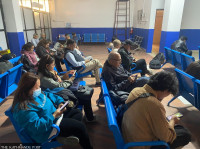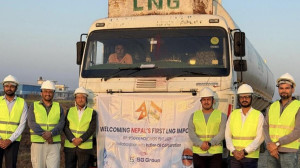Money
Palpa acts to revive hand-woven dhaka and rescue a local icon
The training programme aims to turn out 1,500 dhaka entrepreneurs in three years, officials say.
Madhav Aryal
Sangita BK of Pipaldanda in Rambha rural municipality attended classes for three months to learn to weave Palpali dhaka, a hand-woven fabric widely produced in Palpa in western Nepal.
The training course has armed her with confidence to become a self-employed woman. “I have a skill now. I have seen dhaka cloth before, but I didn't know how it was made," she said.
Renu Palli Magar of Baganaskali-4, Khanichhap has learned embroidery, the craft of sewing designs on cloth. She didn't know how dhaka fabric was woven using a handloom, and now she has mastered the skill.
"I can also make small repairs to the handloom," she said. "I have learned a lot by taking the training."
Besides BK and Magar, the Palpali Dhaka Association in Tansen has taught 198 people to weave dhaka fabric using a handloom.
The federal and provincial governments have implemented the training programme with the support of the UKAID Skills for Employment Programme, Tansen Municipality and Palpali Dhaka Association.
The scheme aims to produce at least 1,500 dhaka entrepreneurs in three years—500 entrepreneurs annually.
"There were some problems due to Covid-19 that forced us to stop the programme abruptly in the last fiscal year," said Purna Maya Maharjan, president of the Palpali Dhaka Association. “But the programme will take more participants next year.”
“The three-year project aims to prevent the art of weaving Palpali dhaka from dying,” said Maharjan.
The federal, state and local governments have also taken the initiative to prepare Dhaka entrepreneurs.
Maharjan, 82, said, "I am hopeful that Palpali dhaka will be revived. Everyone's attention is now focused on traditional fabric."
Few people can be seen weaving dhaka fabric by hand. Tansen Municipality has helped to save the handlooms. The United Nations Development Programme, Rural Economic Development Association has taught 16 women to weave dhaka with eight traditional handlooms.
They learned the craft at Maharjan's weaving factory. The UKAID Skills for Employment Programme has been helping women to become self-employed by becoming entrepreneurs, and is also assisting with market management of the product.
"This is the first project for dhaka fabric," said Hari Rayamajhi, vice-president of the Palpali Dhaka Association. "If the project is successful, it is sure there will be long-term support," he said.
"Our aim is to enable women to become self-employed," said Rayamajhi. "We plan to revive the dhaka industry by establishing the Palpali dhaka brand," he said.
The provincial government plans to establish dhaka fabric as a symbol of Lumbini province. An agreement has been inked to provide training, build handlooms and make women self-employed to save Palpali dhaka.
According to Ashok Kumar Shahi, mayor of Tansen Municipality, the effort aims to make Palpali dhaka popular within the country and in the international market.
"The skill of weaving dhaka has been transforming the lives of women," Shahi said. "It is the duty of the local government to preserve the identity of dhaka," he said.
Shahi expects demand for hand-woven dhaka to swell with the trend shifting towards traditional objects in recent years. He said he would help to promote dhaka. The main objective is to make women self-employed by promoting Palpali dhaka, he added.
He promised to help with market management, export promotion and preservation of the identity of traditional Palpali dhaka. "The brand and label of Palpali dhaka will be different in the market now. The municipality is ready to help," he said.
Sales of Palpali dhaka have expanded, but it faces tough competition from readymade products from India and China. Money is flowing out of the country as a result, and at the same time, entrepreneurs are not getting work, so the Palpali Dhaka Association wants to encourage local production, it said.
"We can make people self-employed by turning them into dhaka weavers," said Manoj Raj Sharma Poudyal, secretary of the Palpali Dhaka Association. "It will help to preserve the identity of dhaka that has gained popularity in the past," he said.
Sagarman Maharjan, ward chairman of Tansen Municipality-6 and a dhaka trader, said the project was designed to benefit women in Tansen and rural areas.
Tansen Municipality has not provided any cash assistance but the Palpali Dhaka Association said it had promised to provide municipal land in the Narayansthan area to set up a Palpali dhaka museum.
Maharjan said the municipality had also given assurances to help those who do not have space at home to keep a handloom.
Binimaya Rana of Tansen Basantapur had no knowledge of Jacquard looms or traditional handlooms, and she said she learned a lot after taking weaving lessons.
Sanu KC of Tansen Bartuk is now able to clearly recognise the different types of dhaka fabrics made using traditional handlooms, pitlung, J-card and machines.
With the advent of modern machine looms, traditional dhaka fabrics and handlooms started getting pushed out, and a campaign was started to save them in Palpa.
Weavers of traditional Palpali dhaka cloth are worried as imported dhaka has begun to take over the market. The local government started teaching women to weave traditional dhaka fabric after even new products made by using J-cards started losing sales to imported dhaka.
Shahi said preparations were underway to create a trademark for traditional Palpali dhaka. This will help buyers to distinguish between the genuine product and fakes so they will not be cheated.
Although more than 1,000 people have become self-employed by weaving and selling Palpali dhaka, the market is full of fake dhaka fabrics imported from India and China.
"The local government, donor agencies and organisations have been active in maintaining the identity of Palpali dhaka cloth in recent times," said Leela Bahadur Karki, executive director of the Rural Economic Development Association.
"We are now ready to teach traditional weavers to move to the next level," he said. "Those who have received training for three months will be provided additional training for three months. This will not only provide self-employment but also save traditional dhaka."
There is no problem in the Palpali dhaka market. Sales are high. But the amount of fake dhaka has increased. "Traders are bringing fake dhaka and selling it as the real thing at low prices," said Maharjan of the association.
Gyanu Karki, proprietor of Karki Dhaka Textile Industry, said that domestic tourists from schools, cooperatives, clubs and organisations from different parts of the country used to buy dhaka products. Till last year, dhaka shops in Tansen numbering a dozen and a half used to be crowded with customers from morning till evening.
Sitam Bhandari, proprietor of Madanpokhara Dhaka shop, said daily sales used to increase up to fivefold during the tourist season.
Dhaka stores saw a daily turnover of more than Rs100,000 each during the tourist season. She said that domestic tourists had boosted the dhaka trade here. Dhaka is the first choice of domestic tourists while only a few foreign visitors show interest in it.
Dhaka products such as hats, scarves, handkerchiefs, purses, waistcoats, bags and ties are popular among domestic tourists who buy them for souvenirs or as gifts for friends and family, Bhandari said.
According to the Cottage and Small Industries Office, only about 1,000 people are currently employed. The number of handlooms has also decreased. The dhaka textile business generates an annual turnover of Rs100 million.




 7.12°C Kathmandu
7.12°C Kathmandu













